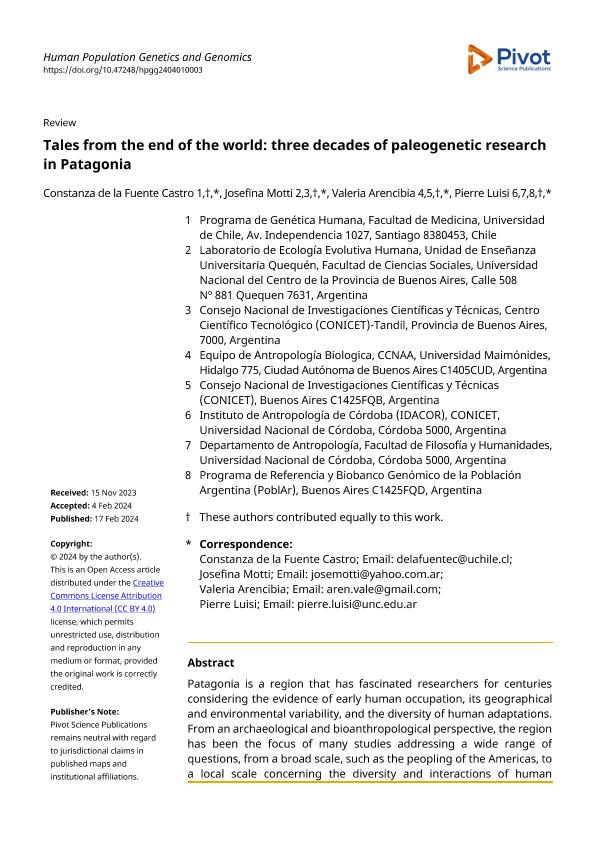Artículo
Tales from the end of the world: three decades of paleogenetic research in Patagonia
Fecha de publicación:
02/2024
Editorial:
Pivot Science
Revista:
Human Population Genetics and Genomics
ISSN:
2770-5005
Idioma:
Inglés
Tipo de recurso:
Artículo publicado
Clasificación temática:
Resumen
Patagonia is a region that has fascinated researchers for centuries considering the evidence of early human occupation, its geographical and environmental variability, and the diversity of human adaptations. From an archaeological and bioanthropological perspective, the region has been the focus of many studies addressing a wide range of questions, from a broad scale, such as the peopling of the Americas, to a local scale concerning the diversity and interactions of human populations. For three decades, paleogenetic studies have contributed to the understanding of population dynamics in the region: first using uniparental markers, particularly mitochondrial DNA in a much larger proportion; and more recently including genome-wide data for ancient individuals. In this work, we revise these studies considering three themes: (1) the first stages of migration into the region; (2) the diversification and interactions of populations during the Middle and Late Holocene; and (3) the link between present-day and ancient populations. While genetic evidence from the early peopling stages is either absent or scarce, making it difficult to evaluate the relative contributions of early South American lineages in the first Patagonian populations, evidence from later periods (from Middle Holocene onwards) is consistent with a single migration wave with founding events and genetic drift acting on small groups during their migration southward. After the initial occupation, the population dynamics seem to have been characterised by the relative isolation of different groups, leading to their differentiation. While there is evidence of some degree of gene flow between groups, the genetic structure in the region is generally associated with geography, subsistence systems, and languages. After European contact, paleogenetic data supports a relative genetic continuity in the region. We finish this review with a fourth theme in which we reflect on the current state and direction of the field in Patagonia, highlighting research lines that will benefit from the implementation of state-of-the-art paleogenomic approach, as well as legal and ethical considerations that would allow to move forward into a more collaborative and inclusive field.
Archivos asociados
Licencia
Identificadores
Colecciones
Articulos(CCT - TANDIL)
Articulos de CTRO CIENTIFICO TECNOLOGICO CONICET - TANDIL
Articulos de CTRO CIENTIFICO TECNOLOGICO CONICET - TANDIL
Articulos(IDACOR)
Articulos de INSTITUTO DE ANTROPOLOGIA DE CORDOBA
Articulos de INSTITUTO DE ANTROPOLOGIA DE CORDOBA
Articulos(SEDE CENTRAL)
Articulos de SEDE CENTRAL
Articulos de SEDE CENTRAL
Citación
de la Fuente Castro, Constanza; Motti, Josefina María Brenda; Arencibia, Valeria; Luisi, Pierre; Tales from the end of the world: three decades of paleogenetic research in Patagonia; Pivot Science; Human Population Genetics and Genomics; 4; 1; 2-2024; 1-34
Compartir
Altmétricas




